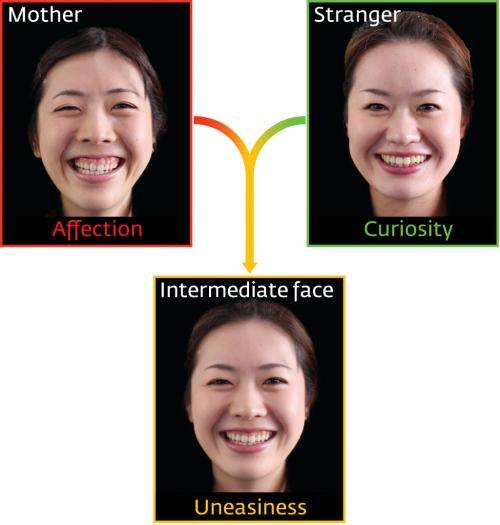Infants show greater unease towards computer-morphed faces when shown 'half-mother' images

When interacting with robots or animations with unnatural-looking faces, many people report a sense of unease. The face seems familiar yet alien, leaving the brain uncertain whether it is definitely human. To make robots more acceptable, it is necessary to understand the roots of these emotional reactions. Research from Japan has now shown that these reactions may begin in early infancy.
Yoshi-Taka Matsuda and colleagues at the Japan Science and Technology Agency, Saitama, and the RIKEN Brain Science Institute, Wako, together with scientists from The University of Tokyo and Kyoto University, studied the reactions of infants to computer-morphed photographs of faces. They showed that this unease, known as the uncanny valley effect, may begin as young as nine months, but only when the morphed image is partly developed from photographs of a familiar person—in this case, their mother.
"Infants like both familiarity and novelty in objects," explains Matsuda. "We wondered how their preference might change when they encountered objects that are intermediate between familiarity and novelty."
Matsuda and his team worked with 57 infants and their mothers. Each child was presented with both morphed and real photographs. The real image was either the child's mother, or a complete stranger. Each morphed photo was created using 50% of the mother's face and 50% of a stranger's face, or a mix of two strangers' faces.
"Infants are as acute observers of human faces as adults are," Matsuda notes. "We created the intermediate faces as naturally as possible using morphing software. It took about six hours to create one morphed face."
The researchers used an eye-tracking system to record where and for how long the infants viewed the images. They found that the infants preferred looking at the photos of their mothers than the 'half-mother' morphed faces, but there was no significant difference between the times they spent looking at real and morphed photos of strangers.
"The 'half-mother' morphed faces could be perceived as lacking in novelty (like the strangers') or any positive connection (like the mothers'), [so] could cause infants to feel disinterest," Matsuda explains. "However, most adults also reported uneasiness related to morphed faces of their mothers, so we interpreted that infants might be having the same reaction."
The team intends to repeat the experiments with fathers' faces; and will test whether infants respond differently to the morphed faces if their relationship with their father is less pronounced than with their mother.
More information: Matsuda, Y.-T., Okamoto, Y., Ida, M., Okanoya, K. & Myowa-Yamakoshi, M. Infants prefer the faces of strangers or mothers to morphed faces: an uncanny valley between social novelty and familiarity. Biology Letters published online before print, 13 June, 2012 (doi: 10.1098/rsbl.2012.0346). rsbl.royalsocietypublishing.or … l.2012.0346.abstract














